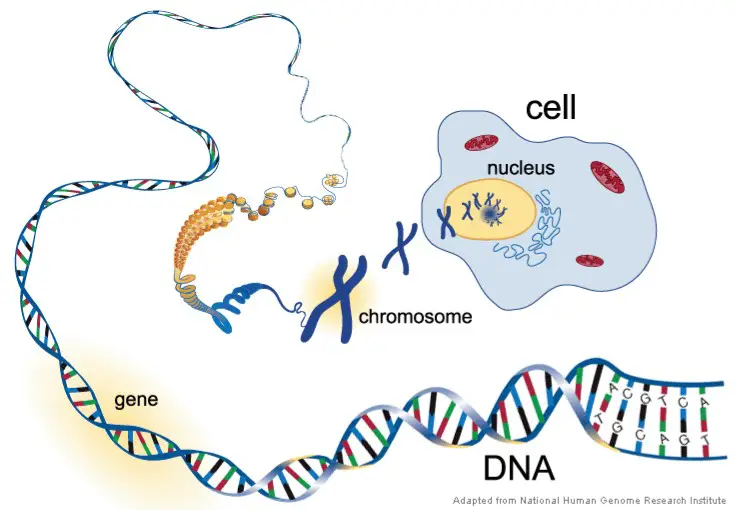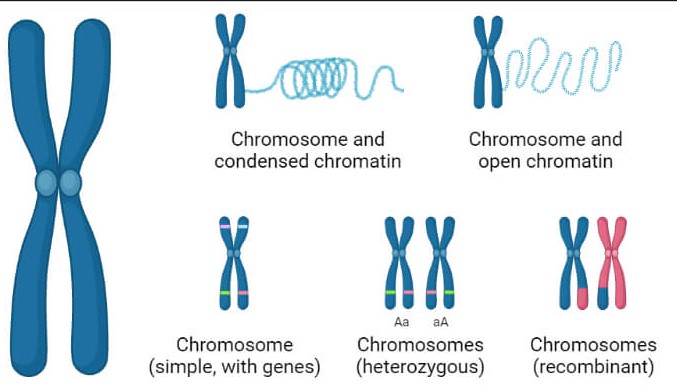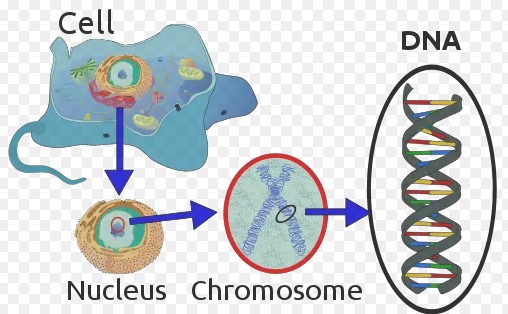The fascinating world of genetics serves as the foundation for understanding the myriad complexities of life, from the traits we inherit from our parents to the way diseases are passed down through generations. At the heart of this genetic landscape are two crucial components: DNA and chromosomes. These elements not only carry our hereditary material but also play pivotal roles in how this information is organized, replicated, and expressed within our cells.
DNA and chromosomes are intimately related; DNA is a long, intricate molecule that contains our genetic instructions, while chromosomes serve as the structures that organize and compact this DNA within the nucleus of our cells. This compact organization ensures that DNA can be efficiently replicated and accurately distributed to new cells during cell division, thereby preserving genetic information from one generation to the next.
The interplay between DNA and chromosomes is fundamental to the processes of life. DNA’s sequence of nucleotides determines our genetic traits, while chromosomes ensure this information is correctly copied, interpreted, and passed on. Understanding this relationship sheds light on everything from genetic inheritance and variability to the molecular basis of diseases and the potential for genetic engineering, making it a cornerstone of both basic biology and medical research.

DNA Basics
Composition
DNA, or Deoxyribonucleic Acid, is the cornerstone of life, a molecule that carries the genetic instructions used in the growth, development, functioning, and reproduction of all known living organisms and many viruses.
Structure of DNA
The structure of DNA is often described as a double helix, resembling a twisted ladder. This unique formation results from two long strands of nucleotides wound around each other. Key components include:
- Sugar-Phosphate Backbone: The sides of the ladder consist of sugar and phosphate molecules.
- Nucleotide Bases: The rungs of the ladder are made up of nucleotide bases paired together through hydrogen bonds: Adenine (A) with Thymine (T) and Guanine (G) with Cytosine (C).
Types of Nucleotides
Nucleotides, the building blocks of DNA, are composed of three parts: a sugar molecule, a phosphate group, and a nitrogenous base. The four types of nucleotides in DNA include Adenine (A), Thymine (T), Cytosine (C), and Guanine (G). These nucleotides are pivotal for encoding genetic information.
Function
Genetic Instructions
DNA serves as a blueprint for the organism’s development and functioning, encoding the instructions for making proteins, which perform most life functions and comprise cell structures.
Protein Synthesis
Protein synthesis involves two key stages: transcription and translation. During transcription, a segment of DNA is copied into RNA (specifically messenger RNA or mRNA), which is then used in translation to assemble proteins based on the sequence of nucleotides in the RNA.
Chromosomes Explained
Structure
Chromosomes are long, thread-like structures made of protein and a single molecule of DNA. They are located in the cell nucleus.
Chromosome Composition
Each chromosome contains a single, tightly coiled DNA molecule wrapped around histone proteins, helping package the DNA into a more compact, manageable form.
Visualizing Chromosomes
Chromosomes are most easily visualized during cell division, particularly the metaphase stage, when they are condensed and aligned in the center of the cell, appearing X-shaped under a microscope.
Role
Storage of Genetic Material
Chromosomes serve as the storage units for genetic information within the nucleus, ensuring DNA is efficiently replicated and accurately distributed during cell division.
Inheritance and Genetic Diversity
Through the process of sexual reproduction, chromosomes are inherited from both parents, contributing to genetic diversity and the unique characteristics of each individual.
Interconnection
DNA in Chromosomes
DNA molecules are tightly packed into chromosomes within the cell nucleus. This packaging is essential for the organization and protection of the genetic information.
How DNA Forms Chromosomes
DNA wraps around histone proteins, forming a complex called nucleosomes, which further coil and fold into the structures recognized as chromosomes.
Chromatin: DNA and Protein Complex
Chromatin is the combination of DNA and proteins that make up the contents of the nucleus of a cell. It exists in two forms: euchromatin (less condensed, active in transcription) and heterochromatin (highly condensed, less active).
Genetic Expression
The relationship between DNA and chromosomes is crucial for genetic expression, the process by which the instructions in our DNA are converted into a functional product, such as a protein.
From DNA to Traits
Genetic traits are expressed through the proteins synthesized based on the instructions in DNA. This process involves gene regulation mechanisms that determine when, where, and how genes are expressed.
Role of Chromosomes in Gene Expression
Chromosomes play a pivotal role in gene expression by structuring the DNA and influencing the accessibility of genes to the transcription machinery, thus controlling which genes are turned on or off.
Cell Division and Genetics
Replication
Copying DNA
Before a cell divides, its DNA must be replicated to ensure each new cell receives a complete set of genetic instructions. This process involves unwinding the DNA molecule and using each strand as a template to synthesize new complementary strands.
Chromosome Duplication
Each chromosome is duplicated before cell division, resulting in two identical sister chromatids connected at a region called the centromere.
Types of Cell Division
Mitosis and Meiosis
- Mitosis is the process of cell division that results in two genetically identical daughter cells, each with the same number of chromosomes as the parent cell.
- Meiosis is a specialized form of cell division that reduces the chromosome number by half, creating four haploid cells, each genetically distinct from the parent cell and from

Genetic Variability
Mutations
Changes in DNA and Chromosomes
Mutations are alterations in the DNA sequence. These changes can occur within genes, affecting a single DNA building block (nucleotide), or they can involve large segments of chromosomes that include multiple genes. Such changes can happen due to errors during DNA replication or as a result of environmental factors like UV light and chemicals.
Impact on Genetics
Mutations can have a wide range of effects on genetics. While some mutations are neutral, having little or no effect on the organism’s function, others can lead to genetic disorders or increase the risk of developing diseases. However, mutations are also a source of genetic variability, providing the raw material for evolution.
Recombination
Genetic Mixing During Meiosis
Recombination, also known as genetic recombination, is a process that occurs during meiosis, the type of cell division that produces sperm and egg cells. It involves the exchange of DNA segments between paired chromosomes, which leads to new combinations of genes.
Importance for Diversity
Recombination plays a crucial role in increasing genetic diversity. By shuffling genes between chromosomes, it ensures that offspring have a mix of traits from both parents, contributing to variation within a population. This genetic diversity is essential for survival and adaptation to changing environments.
Modern Genetics
DNA Sequencing
Reading Genetic Information
DNA sequencing is the process of determining the exact sequence of nucleotides within a DNA molecule. It involves technologies that can read the order of the four bases: adenine (A), guanine (G), cytosine (C), and thymine (T). DNA sequencing has revolutionized the field of genetics, allowing researchers to understand genetic structures and functions more deeply.
Advances in Genomic Studies
Recent advancements in DNA sequencing technologies have dramatically reduced costs and increased speed, making it possible to sequence large amounts of DNA quickly and efficiently. This has led to significant breakthroughs in genomic studies, including the identification of genes linked to diseases, understanding evolutionary relationships, and enhancing personalized medicine.
Genetic Engineering
Modifying DNA and Chromosomes
Genetic engineering involves directly manipulating the DNA of an organism to alter its characteristics. This manipulation can include adding, removing, or altering genetic material at particular locations in the genome. Through genetic engineering, scientists can produce organisms with desired traits or eliminate undesirable ones.
Applications and Ethics
The applications of genetic engineering are vast and varied, including:
- Agriculture: Developing crops that are more resistant to pests and diseases, can tolerate adverse conditions, and have improved nutritional profiles.
- Medicine: Creating gene therapies to treat genetic disorders, manufacturing vaccines, and developing diagnostic techniques.
- Environmental: Engineering bacteria to break down pollutants or produce renewable energy.
However, genetic engineering raises important ethical considerations. These include concerns about the potential for unforeseen consequences, the ethics of modifying organisms, issues of access and equity, and the implications for biodiversity. Debates about the ethical use of genetic engineering continue to be a significant aspect of discussions in the scientific community and the broader public.
FAQs
How are DNA and chromosomes related?
DNA and chromosomes are closely interconnected. DNA is a long molecule that contains our genetic instructions, and these instructions are packaged into structures called chromosomes. This packaging allows the DNA to be organized, replicated, and properly distributed to new cells during cell division, ensuring genetic continuity and diversity.
What role do chromosomes play in genetics?
Chromosomes play a critical role in genetics by housing and protecting DNA, the molecule that carries genetic information. They ensure that DNA is accurately replicated and evenly distributed during cell division, which is crucial for the maintenance of genetic integrity and the process of inheritance.
How does DNA determine genetic traits?
DNA determines genetic traits through its sequence of nucleotides, which encode the information necessary for the synthesis of proteins. These proteins are responsible for various functions and characteristics in an organism. The expression of genes in DNA, which can be influenced by the environment, ultimately determines an individual’s genetic traits.
Can changes in DNA affect chromosomes?
Yes, changes in DNA can affect chromosomes. Mutations, which are changes in the DNA sequence, can lead to alterations in the structure and function of chromosomes. These changes can impact gene expression, lead to genetic disorders, or contribute to the development of diseases like cancer.
Conclusion
The intricate relationship between DNA and chromosomes is a testament to the complexity of biological systems and the marvel of genetic continuity. Through the lens of this relationship, we gain insights into the fundamental mechanisms of life, from the replication of genetic material to the inheritance of traits across generations. It highlights the delicate balance and interdependence within our cells that drive biological diversity and evolution.
Understanding the connection between DNA and chromosomes not only enriches our comprehension of biology but also opens avenues for advancements in genetic research and medical therapies. As we continue to unravel the mysteries of genetics, we inch closer to harnessing its potential to address some of the most pressing health challenges, further illustrating the importance of this foundational relationship in the vast domain of science.

